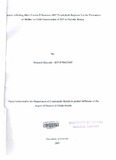| dc.contributor.author | Kinyoki, Damaris | |
| dc.date.accessioned | 2013-05-24T11:15:23Z | |
| dc.date.available | 2013-05-24T11:15:23Z | |
| dc.date.issued | 2010 | |
| dc.identifier.citation | Masters of Public Health | en |
| dc.identifier.uri | http://erepository.uonbi.ac.ke:8080/xmlui/handle/11295/25368 | |
| dc.description.abstract | Introduction: The enormous progress in Kenya in mobilizing the Human Immunodeficiency
Virus (HIV) infected pregnant women to access the antiretroviral (ARV) prophylaxis provides a
real opportunity for preventing the mother to child transmission (PMTCT) of HIV. Previous
studies have demonstrated that simpler and more cost-effective regimens such as single dose
nevirapine (sdNVP) and/or short course zidovudine used alone or in combination could achieve
mother to child transmission (MTCT) reductions of up to 50% or more. Recent evidence
strongly supports the use of efficacious dual regimens of ARV prophylaxis especially short
course zidovudine (AZT) and single dose NVP, to achieve a more dramatic reduction in perinatal
transmission of HIV.
Objectives: The overall purpose of this study was to determine the factors affecting uptake of
short course zidovudine C"\ZT) and sdNVP regimen amongst HIV positive pregnant women in
Nairobi Kenya. Secondly, the study was to determine the level of uptake and provide specific
recommendations to susta.n high levels of uptake to this demanding AR V prophylaxis regimen.
Methodology: A cross sectional study was conducted from January to August 2009 in health
facilities in Nairobi, Ken/a. Both quantitative and qualitative approaches were used to collect
primary and secondary data. Interviews were conducted among health workers and HIV positive
mothers in the health fac.Iities. Quantitative and qualitative data was processed, tabulated, and
analyzed using SPSS version 13 to generate frequency tables and graphs. Chi square analyses
were done to determine measures of association.
Results: In this study the antenatal mother AZT +sdNVP regimen uptake in the health centers
was at 14% and in the hcspitals was at 17%. There was significant statistic association between
the uptake of ARV prophylaxis with the following factors: level of knowledge of the health
workers (P=0.042), ARY prophylaxis dispensing points (P=0.01), HIV positive women who
received support (P=O.OYOand antenatal clinic attendance (P-value=O.OO). However there was no
statistical difference between the uptake of ARV prophylaxis with marital status (Pvalue=
0.789), number of children (P-values=0.068) and monthly income (P-values=0.274).
Conclusion and Recommendations: Therefore there are still daunting challenges with regard to
ARV availability, accessibility and utilization. The results suggest key improvements would be
improving inequity in distribution of ARV dispensing sites, training of service providers on the
whole aspect of PMTCT and creation of awareness amongst HIV positive pregnant women | en |
| dc.language.iso | en | en |
| dc.publisher | University Of Nairobi | en |
| dc.title | Factors Affecting Short Course Efficacious ARV Prophylaxis Regimen Use for Prevention of Mother to Child Transmission of HIV in Nairobi, Kenya | en |
| dc.type | Thesis | en |
| dc.description.department | a
Department of Psychiatry, University of Nairobi, ; bDepartment of Mental Health, School of Medicine,
Moi University, Eldoret, Kenya | |
| local.publisher | College of Health Sciences | en |

